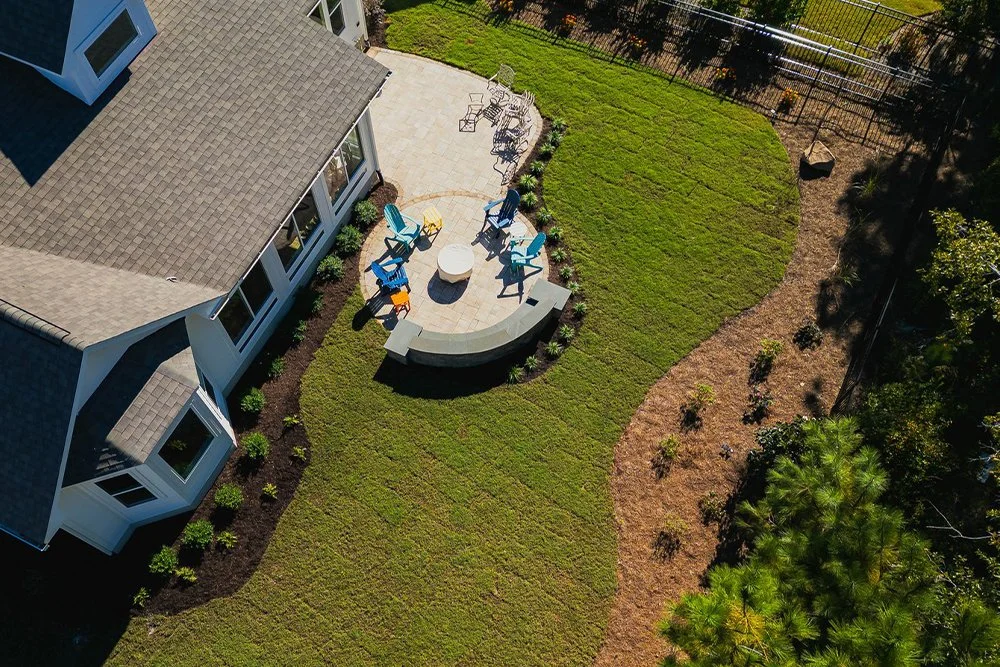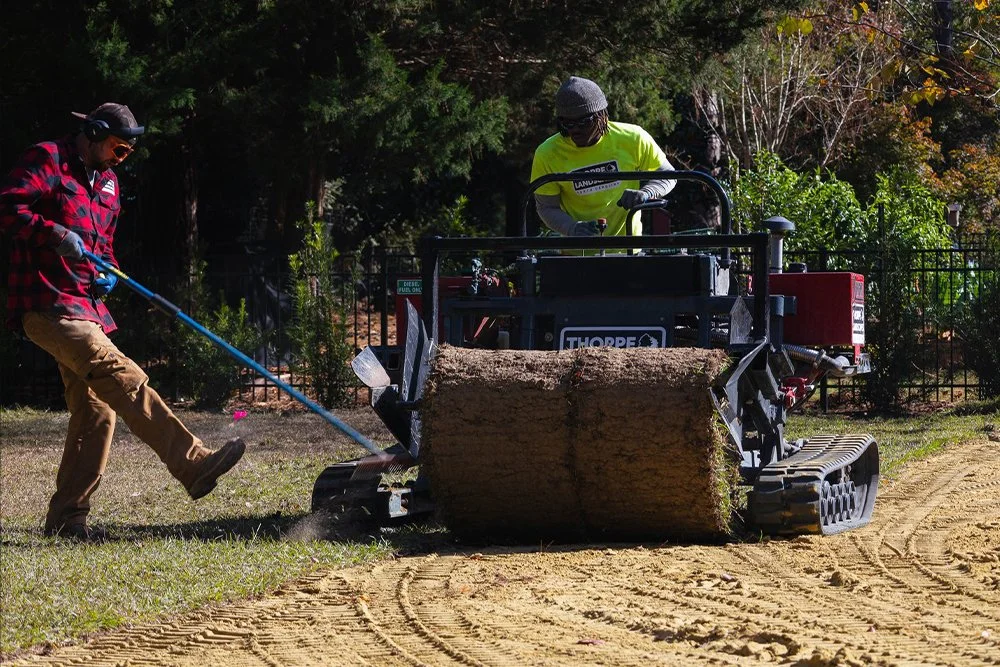Turf Wars: Sod vs. Synthetic
Choosing between natural sod and synthetic turf isn’t just about looks—it’s about lifestyle, climate, maintenance, and long-term value. Whether you're aiming for a lush, barefoot-friendly lawn or a hassle-free green space that holds up to pets and play, the right choice depends on your property’s needs and your personal preferences.
In this guide, we break down the benefits and drawbacks of each option to help North Carolina homeowners make the best decision for their yards. Let’s settle the turf war once and for all.
Benefits of Sodding Your Lawn
· Stay Cool- Natural evaporation keeps your lawn and bare feet comfortable during hot summer months.
· Boost Curb Appeal- A vibrant, living landscape can increase your home’s value by 10–15%.
· Erosion Control- Deep-rooted grass helps stabilize soil and prevent erosion on sloped lots.
Downside of Sodding Your Lawn
· Daily Watering- Your new sod needs consistent moisture for the first month to ensure proper root establishment.
· Regular Mowing- Encourages strong root growth, thickens the lawn, and keeps your new grass healthy and even.
· Pests & Diseases- Grubs, fungus, and weeds may appear over time—be prepared to treat them with physical removal or chemical solutions.
Sod is ideal for homeowners who are looking for a premium look, enjoy light yard work, and have irrigation on hand. Learn more about our sod installation services.
Benefits of Installing Turf
· Always Lush- Turf stays at your ideal height—no mowing required.
· Save Water- Up to 55 gallons of water per square foot each year.
· Allergy-Free- Enjoy the outdoors without pollen clouds or sneezing fits.
· Low Maintenance- Let kids and pets play freely—no mud, no mess, no hassle.
Downside of Installing Turf
· High up-front costs: Installing synthetic turf costs 1.5-2x more than sod.
· Heat buildup: Surface temperature can be 20°F hotter than natural sod.
· Not a “set-it-and-forget-it”: Leaves, spills, and pet messes still need be to be cleaned up.
Turf is ideal for busy families, rental properties, commercial properties, or drought-prone zones with irrigation. Discover our turf services.
How to choose for your North Carolina lawn?
· Beach Bungalow- Coastal conditions like salty air and sandy soil can be tough on natural grass. Turf offers a worry-free solution with no browning from salt spray and no need to navigate watering restrictions—just reliable green all year long.
· Mountain Cabin- On sloped lots with thin soil, sod provides natural erosion control and blends beautifully into the surrounding landscape. Its root system helps stabilize the ground while creating a lush, natural look.
· Urban Home- In smaller city spaces, turf makes a lot of sense—low maintenance, durable, and always neat. But if you're after a touch of nature, a small patch of sod can work wonders in softening hardscapes.
Whether you go with sod or turf, each has unique strengths—it's all about what fits your space, style, and lifestyle best.
Pro Tips from the Thorpe Crew
· Mix and Match- Use sod for curb appeal in the front and low-maintenance turf for a kid- and pet-friendly backyard play zone.
· Build It Right- A smooth, well-draining, laser-leveled base is key—it's 80% of what makes your sod or turf look great.
· Timing Matters- Sod takes root best in early fall. Turf can be installed anytime, but pros prefer the mild temps of late spring.
FAQs
Q: How long before I can walk on fresh sod?
A: You can take light steps on your new sod after about 10 days, but hold off on heavy use for 3 weeks to allow the roots to firmly establish.
Q: Will turf get moldy in North Carolina’s humidity?
A: Not if it’s installed correctly! Proper drainage is key. At Thorpe, we use a permeable base that allows rainwater to flow through instead of collecting underneath.
Q: What’s the best time of year to install sod or turf?
A: Sod installs best in early fall or spring, when temperatures are mild and roots can establish without heat stress. Turf, on the other hand, can be installed year-round.
Q: How long does turf last?
A: With proper installation and care, quality turf can last 15–20 years—making it a long-term, low-maintenance investment.
Q: Is one option better for pets?
A: Both are pet-friendly! Turf is great for high-traffic, muddy-prone zones since it drains quickly and won’t develop bald spots. Sod offers a natural feel and is soft on paws—but may need more care to stay clean and durable.
Q: Can I install sod or turf myself?
A: You definitely can… but fork-lifting pallets of sod or power brooming turf seams is back-breaking. Most homeowners call the pros to get it right.
Whether you’re Team Sod or Team Turf, Thorpe Landscapes has your North Carolina yard covered. Contact us today for a free estimate.





